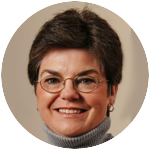
Effie Caldarola
When the ground shifts beneath your feet, you fall back on faith.
Sometimes, it’s a small earthquake that jolts you from deep slumber. Your spouse may not even stir unless it’s a really good slammer.
Other times, you’re hauling the laundry up the stairs and it rolls in slowly. Or a desk lurches slightly and your co-workers ask the familiar question, “Was that an earthquake?”
That’s life in Alaska. Part of the Ring of Fire that stretches through Japan and up the west coast of the U.S., Alaska is one of the most seismically active places in the world. Consider this: By Dec. 27, 52,146 earthquakes had been recorded in Alaska in 2018, according to the Alaska Earthquake Center at the University of Alaska Fairbanks.
[hotblock]
Of course, Alaska is huge, most of those quakes were relatively small, many in unpopulated areas. But during the over 30 years I lived in Alaska, I can’t begin to count the number of temblors I experienced.
So I felt fortunate to miss the magnitude 7.0 quake that hit on the morning of Nov. 30, 2018. Infrastructure was damaged, a few fires broke out, one public school may remain closed for the year, but the damage was minimized by stringent building codes.
So when I called the little Catholic elementary school, St. Elizabeth Ann Seton, that my children had attended in Anchorage, I was curious to see how everyone had weathered the quake. Ostensibly, I was doing a story for the archdiocese’s Catholic Anchor newspaper on Catholic Schools Week activities, sponsored nationally by the National Catholic Education Association Jan. 27 to Feb. 2.
But I quickly found out that if you wanted to boast about Catholic education, my kids’ alma mater’s response to the earthquake was the best advertisement.
The quake began just as school was about to open for the day. The before-care students were lined up. Their supervisor quickly had them gather by an inside wall. Aside from broken glass, there was no damage.
After the rolling stopped, frightened little kids regrouped in the hallway.
[tower]
Staff offered calm. Then, from the church upstairs appeared three priests: the pastor, his assistant and a visiting priest. Along with them was the parish deacon, himself a dad. Four ordained ministers to console 169 terrified kids: a good ratio.
My friend Lisa has taught first grade at St. Elizabeth for years. In the interview, she told me that when school resumed a few days later, she had a lot of very anxious students. One little girl wore her mom’s school sweatshirt, the note from home explaining, “She wants to have a part of me with her.”
To assuage fears, Lisa went to the church and brought holy water for a bowl on her desk.
“If you feel frightened or worried,” she told her class, “just come up and put your fingers in the holy water, bless yourself, and thank God that you are safe and that God is in control.”
Some children made several trips to the holy water.
Catholic sacramentals can be powerful, consoling. We are a tactile faith, an earthy faith that uses all of our senses in worship. We consume the body and blood of our Savior. We want the comfort of touch and ritual.
When one of the parents heard about Lisa’s holy water, he posted it on Facebook with the notation, “This is why I send my children to Catholic school.”
With Catholic Schools Week approaching, I recalled how much money we spent sending three kids to that school. But, how, I pondered, could you possibly put a price tag on that?



I homeschooled my daughter and we didn’t have to worry about being separated by her being at school. I’m just saying.